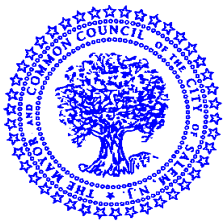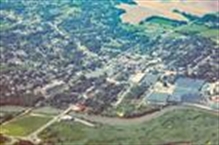The town and colony of Salem was laid out in 1675 by a Quaker, John Fenwick and the community was given permission to choose officers in October 1693.
It was incorporated on February 21, 1798, as part of the initial group of 104 townships established by the New Jersey Legislature. On February 25, 1858, it was reincorporated as Salem City.The name “Salem”, in both the city and county, is derived from the Hebrew word shalom, meaning “peace”. It is also related to the Arabic “saalam”, also “peace”.
It was incorporated on February 21, 1798, as part of the initial group of 104 townships established by the New Jersey Legislature. On February 25, 1858, it was reincorporated as Salem City.The name “Salem”, in both the city and county, is derived from the Hebrew word shalom, meaning “peace”. It is also related to the Arabic “saalam”, also “peace”.
Click this thumbnail to see a larger image. Salem from the air sometime in the 1970s
Salem was the home of early agricultural pioneers, such as city father Colonel Robert Johnson, famously (but probably falsely) promoted as the first person to publicly promote the consumption of tomatoes. However, the area around Salem grew to be one of America's most prolific tomato growing and canning centers, with our products being shipped to and enjoyed in every country of the world.
Salem also became a major glass- and bottle- manufacturing center with the operation of the Gaynor, and Salem Glass Works, later the Anchor-Hocking company plants.
The Old Salem County Courthouse is the oldest active courthouse in New Jersey and is the second-oldest courthouse in continuous use in the United States. The Courthouse was erected in 1735 during the reign of King George II using locally manufactured bricks. The building was enlarged in 1817 and additionally enlarged and remodeled in 1908. Its distinctive bell tower is essentially unchanged and the original bell sits in the courtroom.
The city's centerpiece is fhe famous "Salem Oak", a 500-year old oak along Broadway that was recently judged to be the largest white oak tree in New Jersey, and one of the largest in the country.
Salem also became a major glass- and bottle- manufacturing center with the operation of the Gaynor, and Salem Glass Works, later the Anchor-Hocking company plants.
The Old Salem County Courthouse is the oldest active courthouse in New Jersey and is the second-oldest courthouse in continuous use in the United States. The Courthouse was erected in 1735 during the reign of King George II using locally manufactured bricks. The building was enlarged in 1817 and additionally enlarged and remodeled in 1908. Its distinctive bell tower is essentially unchanged and the original bell sits in the courtroom.
The city's centerpiece is fhe famous "Salem Oak", a 500-year old oak along Broadway that was recently judged to be the largest white oak tree in New Jersey, and one of the largest in the country.





























